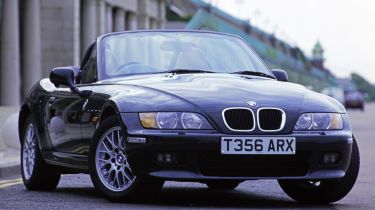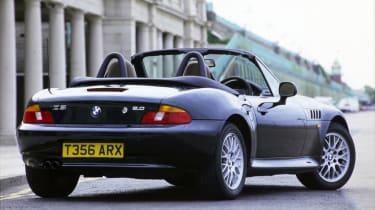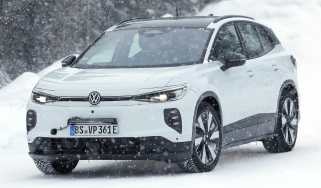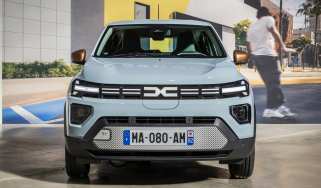Used BMW Z3 (1995-2002) review: a modern classic
A full used buyer’s guide on the BMW Z3 sports car that was on sale between 1995 and 2002
Verdict
There are more than enough Z3s on the market, with some owners selling up because of the expanded ULEZ in London. The result is keen prices and something for everyone; it also helps that at this time of year few people are thinking of buying a two-seat convertible, but don’t forget that spring is just around the corner… Even really nice Z3s aren’t worth a lot, so there’s no point buying anything ropey because it’ll almost certainly prove to be a false economy. The stylish Z3 provides top-down fun, yet it’s user-friendly. Running and purchase costs are sensible, but there’s plenty of performance for everyday use. The Z3 model range is also wide, with engines from mild to wild, making this an ideal classic sports car.
BMW’s advertising slogan used to be ‘The Ultimate Driving Machine’, so you’d think that it has a long history of producing driver-focused sports cars. In reality, after the company’s founding in 1916, BMW didn’t build a mainstream two-seater until the introduction of the Z3 in 1995. Arriving six years after the Mazda MX-5 burst onto the scene, the Z3 was launched just as the affordable drop-top segment went into overdrive. As a result, the BMW was up against some tough competition, but that didn’t stop the Z3 from quickly becoming hot property, helped by a starring role in James Bond flick GoldenEye. Nearly three decades on, the Z3 is now a bona fide modern classic that could provide you with a lot of cheap fun this summer.
History
The Z3 arrived in early 1995, in four-cylinder 1.9-litre form; at the end of 1997 the six-cylinder Z3 2.8 was introduced. Things got serious in January 1998, with the arrival of the M Roadster; eight months later the Z3M Coupé hit showrooms.
Used - available now

2020 BMW
X5
63,636 milesAutomaticDiesel3.0L
Cash £31,697
2023 Audi
A6 Avant
23,089 milesAutomaticPetrol2.0L
Cash £27,176
2017 Audi
A4
64,213 milesManualPetrol1.4L
Cash £8,750
2023 Mercedes
A-Class
60,987 milesAutomaticDiesel2.0L
Cash £15,650In April 1999, four-cylinder 1.8 and six-cylinder 2.0-litre engines superseded the 1.9, and a facelift brought restyled wheelarches, boot lid, rear lights and bumpers. A 3.0-litre engine replaced the 2.8-litre unit in June 2000, then in October a 2.2-litre engine took the place of the 2.0-litre powerplant.
From February 2001, 2.2 and 3.0 Sport Roadsters were available with sports suspension, 17-inch alloy wheels and electric seats. From June 2001 a 1.9 Sport Roadster was also offered; its spec is the same as the 2.2 and 3.0 editions.
Which one should I buy?
Any good Z3 will provide plenty of smiles per pound, but the six-cylinder models give the greatest pleasure, thanks to their extra muscle, as well as a much nicer soundtrack.
While six-cylinder cars are generally the most sought after, the greater reliability and lower running costs of the four-pot models mean these also have a following.
Autos are unusual and demand for these is low, but it’s a decent transmission and when bolted to a big six-cylinder engine, it turns the Z3 into an excellent cruiser.
As is often the case when entering the realms of a ‘modern classic’, it doesn’t necessarily pay to seek out the lowest- mileage cars. A carefully maintained example could offer greater financial benefit if it’s already had some significant expenditure invested in it.
Alternatives to the BMW Z3
The Lotus Elise is now very expensive, and nothing like as civilised or as usable as the Z3, but it’s tremendous fun to drive. More comparable to the BMW is the Mercedes SLK, which is in good supply, easy to own and cheap to buy, but look out for corrosion. The MG F and TF are excellent value, plentiful, and great fun to drive, and although they have a reputation for fragility, there are enough good ones to go round.
The Audi TT is well made and very usable in roadster form, plus as with the BMW and Mercedes there are four or six-cylinder engines and manual or automatic gearboxes. The driver’s choice is the Porsche Boxster, which set the dynamic benchmark, while a less obvious choice is the front-wheel-drive Alfa Romeo Spider, launched in 1995.
What to look for
Suspension
Worn rear subframe bushes are common, as are tired rear shock absorber mounts, given away by rattles when driving.
Wear
Crash-damaged cars and rust are unusual. Hard-driven Z3s can suffer from the diff trying to break away; check for cracked welds.
Roof
The roof mechanisms rarely give problems. Most are electric, but not all. The window seals can leak, though, leading to a wet cabin.
Emissions
Some owners are selling up because their Z3s aren’t London ULEZ-compliant. However, the 2.2, 3.0 and later 1.9-litre engines are exempt.
Common faults
These cars are all quite old and few are worth very much, so a lot of traders don’t touch them. As a result many Z3s are being sold privately, which means you get more car for your money, but no warranty. So buy carefully.
Interior
Of course the Z3’s interior is now rather dated, but that doesn’t make it any less desirable. Perhaps the opposite, with a lack of touchscreens, so there are physical buttons for everything. The build quality is good, but a quarter of a century of exposure to the sun may not have done the trim any favours.
The seats are supportive and the driving position is excellent, while the dash is well laid out and easy to get on with. Practicality isn’t the best, but there’s some storage space behind the two seats, and the boot has a reasonable capacity of 165 litres, whether or not the roof is in use.
Prices
The higher a Z3’s spec, the more it’s worth. That puts the four-cylinder models at the bottom of the pile, and in a private sale you can bag a high-mileage example relatively cheaply. There are plenty of 2.0 and 2.2-litre cars, but the 2.8 and 3.0 models are a lot more unusual.
To check prices on a specific model head over to our valuation tool.
Running costs
Even in the mid-nineties BMWs featured condition-based servicing, so the car flags up when attention is due. It takes into account lots of factors, but the most that a Z3 can go between services is two years or 18,000 miles; driven hard or in adverse conditions, it could be a lot less.
Some parts are replaced when necessary, rather than according to a schedule, but services alternate between Inspections I and II, which are priced at £199-£241 and £312-£386 respectively. Brake fluid needs to be renewed every two years at £65, but there’s no schedule to replace the coolant because long-life fluid is used, so is only renewed if the cooling system is drained. All Z3 engines are chain-driven, so there are no cambelts to change.
Recalls
The recalls system pre-dates the Z3’s arrival, but there are no campaigns listed for it. However, there are other recalls listed from the brand, going back as far as 1992. A couple of recalls are listed for the E36-generation 3 Series on which the Z3 was largely based, but these didn’t affect the roadster. With the newest Z3s now more than two decades old, any manufacturing glitches should have been fixed a long time ago, either within warranty by a dealer, or years later by an independent specialist.
Ultimately, it’s not any Z3’s earliest years that you need to focus on in terms of the maintenance regime; it’s the last decade that’s the most important, so go through the service history very carefully and make sure that previous owners haven’t skimped, potentially leaving you to pick up a hefty bill.
Driver Power owner satisfaction
The last Z3s were built in 2002, so they fall outside the remit of our Driver Power surveys. Even when new, many Z3s were bought by enthusiasts who accepted the limited practicality and sometimes high running costs. Now that these cars are usually bought as toys for occasional use, those shortcomings are recognised even more readily. No problem when the Z3 gives so much in return for so little.






